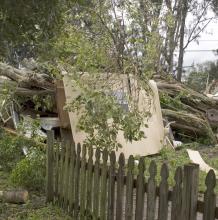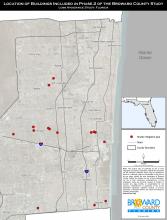Study Summary
Study Area – Broward County
Hazard Type – Hurricane wind
Project Type – This study includes 12 hurricane wind mitigation projects, including improvements to windows, vents, and/or doors by installing shutters, impact-resistant glass, or protective film on 15 buildings.
Total Project Cost – $2,151,862
(12 projects; 2011 dollars)
Total Losses Avoided – $10,398,664 (2011 dollars)
Return on Investment (ROI) – 4.83
Pre- and Post-Mitigation Events
Southeastern Florida, which includes Broward County, has the highest frequency of hurricanes in the United States. Since 1992, Broward County has had eight Presidential Disaster Declarations for hurricanes and tropical storms. Between March 1999 and July 2005, the county had six Presidential Disaster Declarations, including Hurricane Irene (1999), Charley (in conjunction with tropical storm Bonnie, 2004), Frances (2004), Jeanne (2004), Katrina (2005), and Wilma (2005). These events resulted in deaths and injuries and cost residents, businesses, and taxpayers billions of dollars in repairs.

FEMA Photo Library
Loss Avoidance Methodology
In 2011, Broward County initiated a loss avoidance study of hurricane wind mitigation projects as part of a comprehensive effort by the Broward County Emergency Management Division to develop a continuous and integrated mitigation and recovery process. Thirty-two hurricane wind mitigation projects to 64 buildings, which were completed between March 1999 and July 2005, were considered for the Broward County study. The projects were funded by FEMA, other public agencies, and private sources.
The following types of hurricane wind mitigation projects were initially considered for the study:
• Shutter – Hardening the building envelope by protecting windows, vents, and door openings with shutters or other systems that meet the debris impact and wind pressure design requirements of the adopted building code. Shutter mitigation includes installing shutters on windows, vents, or bay doors and installing impact-resistant glass or protective film on windows.
• Roof – Securing the building envelope and increasing the structural integrity by upgrading or improving the roof deck or coverings. For wood-framed roofs, this upgrade includes strengthening the connection of the decking to the supporting rafters and trusses, typically by using larger nails or smaller nail spacing, and replacing any degraded deck panels.
• Code Plus – Designing a new building to a level that exceeds the local building codes (e.g., designing a building for a maximum wind speed of 150 mph instead 110 mph). This type of mitigation applies only to new construction.
Of the wind events analyzed for the Broward County study, only the October 2005 event (Hurricane Wilma) had wind conditions providing significant wind speeds greater than the 85-mph wind speed threshold used in the FEMA Benefit-Cost Analysis (BCA) Tool wind damage functions, which were used to determine the losses avoided (building and content damages and loss of public services). Because of this, losses avoided could only be determined for shutter projects and not roof or code plus projects due to lack of data.
Twenty projects with 49 buildings were eliminated from the study because of inadequate or incomplete data. The 12 projects that were selected were mainly wind retrofit activities, including improvements to windows, vents, and/ or doors by installing shutters, impact-resistant glass, or protective film.
Figure 2 shows locations of the 15 building included in the study. The performance of these projects during Hurricane Wilma was compared to the damage that would have occurred if the projects had not been implemented.

Return on Investment
The aggregate losses avoided for the 15 buildings were valued at $10.4 million using the FEMA BCA Tool, and the aggregate project cost for the 15 buildings was valued at $2.2 million (both in 2011 dollars), resulting in a ROI of 4.8 for the hurricane event studied. The results of the study demonstrate the cost-effectiveness of the selected projects on an aggregate basis.
Only one major hurricane has struck Broward County since the projects were completed. The value of the losses avoided will increase if additional hurricane-force winds occur during the projected lifespan of the projects.

